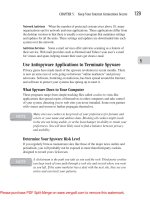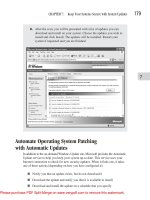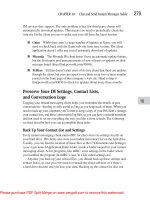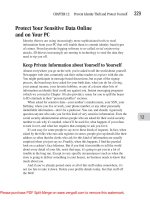how to do everything with ms office excel 2003 phần 7 pdf
Bạn đang xem bản rút gọn của tài liệu. Xem và tải ngay bản đầy đủ của tài liệu tại đây (1 MB, 44 trang )
246 How to Do Everything with Microsoft Office Excel 2003
HowTo-Tght (8) / How to Do Everything with Microsoft Office Excel 2003 / Hart-Davis / 3071-1 / Chapter 12
Clear a Data Table
Because a data table consists of an array formula, you have to clear the whole of it at once rather
than just part of it. (See “Work with Array Formulas,” in Chapter 8, for an explanation of array
formulas.) If you try to clear just part of the data table, Excel displays this error message box:
To clear the values from the data table, select the range of cells that contains the values, and
then choose Edit | Clear | Contents or press
DELETE. Make sure you don’t select any formula cells.
To clear a data table entirely, select every cell in the range it occupies, including all cells that
contain formulas, and then choose Edit | Clear | All.
Explore Alternative Data Sets with Scenarios
Excel’s scenarios feature lets you define and use alternative data sets within the same workbook.
Instead of creating a separate version of a workbook and using it to experiment with different
values or different formulas, you can use scenarios to experiment more comfortably without
damaging your main workbook. Better yet, you can create a what-if model in a workbook, share
it with your colleagues so that they can admire your scenarios and perhaps create their own, and
track the results of the changes your colleagues make to the scenarios.
Create the Worksheet You Want to Manipulate with Scenarios
The first step in using scenarios is to create the worksheet you want to manipulate and to define
names for the cells whose values will be manipulable in the scenarios. Defining names isn’t
necessary, because you can refer to cells by their references instead, but names make the process
so much clearer that you’ll almost always want to define them.
Create the worksheet by using the methods you’ve learned so far in this book. Figure 12-1
shows the worksheet I’ll use for examples in the following sections. It summarizes the sales,
costs, profit, profitability, and contribution to profitability of the six categories of products that
the microbrewery we’ve visited already in this book makes.
The worksheet is relatively straightforward:
■
The figures in the Sales column are total sales figures drawn from the underlying
worksheets. The total at the bottom of the column adds the sales figures together.
■
The figures in the Costs column are total costs figures (production and distribution costs)
drawn from the underlying worksheets. The total at the bottom of the column adds the
costs figures together.
P:\010Comp\HowTo8\071-1\ch12.vp
Thursday, August 28, 2003 12:11:39 PM
Color profile: Generic CMYK printer profile
Composite Default screen
12
CHAPTER 12: Solve Problems by Performing What-If Analysis 247
HowTo-Tght (8) / How to Do Everything with Microsoft Office Excel 2003 / Hart-Davis / 3071-1 / Chapter 12
■
The figures in the Profit column are calculated by subtracting each product’s costs from
its sales. The total at the bottom of the column adds the profit figures together.
■
The percentages in the Profitability column are calculated by dividing each product’s
profit by its total sales. The figure at the bottom of the column is the overall profitability,
calculated by dividing the total profit by the total sales.
■
The percentages in the Contribution column are calculated by dividing each product’s profit
by the company’s total profit (cell D11). The total at the bottom of the column adds the
contribution figures to confirm that they represent 100 percent and that nothing is missing.
The brewery’s management team will use scenarios to examine what happens when they
change the figures in the Sales column and the Costs column. To help the team see instantly
which value they’re manipulating, each of the figures in the Sales column and the Costs column
(apart from the totals) has a descriptive name defined for it: Health_Sales, Health_Costs,
Feedstuffs_Sales, Feedstuffs_Costs, and so on. The longer names are shortened a little (Health
instead of Health Products, Std Lager instead of Standard Lager, and so on) because the Scenario
Values dialog box truncates longer labels.
After creating the worksheet, save it (press
CTRL-S) before proceeding.
Open the Scenario Manager Dialog Box
To work with scenarios, you use the Scenario Manager dialog box (choose Tools | Scenarios).
Figure 12-2 shows the Scenario Manager dialog box as it first appears when you display it in a
workbook that contains no scenarios.
FIGURE 12-1 The sample worksheet used for scenarios
P:\010Comp\HowTo8\071-1\ch12.vp
Thursday, August 28, 2003 12:11:40 PM
Color profile: Generic CMYK printer profile
Composite Default screen
248 How to Do Everything with Microsoft Office Excel 2003
HowTo-Tght (8) / How to Do Everything with Microsoft Office Excel 2003 / Hart-Davis / 3071-1 / Chapter 12
Create a Scenario for Your Starting Point
Before you add any other scenarios, create a scenario that represents the starting point for the
worksheet. This scenario enables you and other users to easily return to the starting values and
assumptions for the worksheet.
To create a scenario for your starting point, follow these steps:
1. If the Scenario Manager dialog box isn’t already displayed, choose Tools | Scenarios to
display it.
2. Click the Add button to display the Add Scenario dialog box (Figure 12-3).
3. Enter the name (for example, Starting Scenario) in the Scenario Name text box.
4. Click in the Changing Cells text box, and then select the cells in the spreadsheet that will
be changeable in the scenario:
■
Click and drag to select contiguous cells. CTRL-click to add noncontiguous cells to
the current selection.
■
Excel automatically collapses the Add Scenario dialog box while you select cells in
the worksheet, so you don’t need to click the Collapse Dialog button to collapse the
dialog box manually. Excel restores the dialog box after you finish making a selection.
■
After you make a selection, Excel changes the dialog box’s title from Add Scenario
to Edit Scenario. Otherwise, the dialog box remains the same.
FIGURE 12-2 Use the Scenario Manager dialog box to create and manipulate scenarios.
P:\010Comp\HowTo8\071-1\ch12.vp
Thursday, August 28, 2003 12:11:40 PM
Color profile: Generic CMYK printer profile
Composite Default screen
12
CHAPTER 12: Solve Problems by Performing What-If Analysis 249
HowTo-Tght (8) / How to Do Everything with Microsoft Office Excel 2003 / Hart-Davis / 3071-1 / Chapter 12
5. Enter a comment (if appropriate) in the Comment text box.
6. Select or clear the Prevent Changes check box and the Hide check box as necessary.
See the next section, “Add Further Scenarios,” for details on these check boxes.
7. Click the OK button to close the Edit Scenario dialog box. Excel displays the Scenario
Values dialog box, displaying the current values for each of the changeable cells:
8. For the starting scenario, you don’t need to change the existing values. Click the OK button to
close the Scenario Values dialog box. Excel returns you to the Scenario Manager dialog box.
FIGURE 12-3 Start by using the Add Scenario dialog box to create a scenario that represents
the starting point for the worksheet.
P:\010Comp\HowTo8\071-1\ch12.vp
Thursday, August 28, 2003 12:11:40 PM
Color profile: Generic CMYK printer profile
Composite Default screen
250 How to Do Everything with Microsoft Office Excel 2003
HowTo-Tght (8) / How to Do Everything with Microsoft Office Excel 2003 / Hart-Davis / 3071-1 / Chapter 12
Add Further Scenarios
To add another scenario, repeat the steps you took to create the starting scenario, but with these
differences:
■
Enter a different (and descriptive) name for the scenario in the Add Scenario dialog box.
■
Change the selection of changeable cells only if necessary. Excel automatically suggests
those cells that are defined in the first scenario you defined.
■
Change the appropriate values in the Scenario Values dialog box to effect changes in
the worksheet. As well as typing values, you can enter formulas in the Scenario Values
dialog box to change the existing cell contents. For example, to see what effect a 25
percent decrease in costs would look like, enter =.75* before the existing value. Excel
displays this message box to tell you that it has converted the formula result to a value;
click the OK button:
■
Select the Prevent Changes check box if you want to prevent changes to the scenario. After
selecting this check box, you need to implement protection by using a Tools | Protection |
Protect Sheet command.
See “Protect Cells, a Worksheet, or a Workbook,” in Chapter 14, for an explanation of
protecting worksheets and workbooks.
■
Select the Hide check box if you want to hide the scenario from other users. After selecting
this check box, you need to implement protection by using a Tools | Protection | Protect
Sheet command.
Edit and Delete Existing Scenarios
To edit an existing scenario, select its entry in the Scenarios list box in the Scenario Manager dialog
box, click the Edit button, and then work in the Edit Scenario dialog box. Excel automatically adds
details of the modification to the comment attached to the scenario—for example, Modified by
Jason Acme on 11/22/2003. After making such edits as are needed, click the OK button.
P:\010Comp\HowTo8\071-1\ch12.vp
Thursday, August 28, 2003 12:11:40 PM
Color profile: Generic CMYK printer profile
Composite Default screen
12
CHAPTER 12: Solve Problems by Performing What-If Analysis 251
HowTo-Tght (8) / How to Do Everything with Microsoft Office Excel 2003 / Hart-Davis / 3071-1 / Chapter 12
To delete a scenario, select its entry in the Scenarios list box in the Scenario Manager dialog
box and click the Delete button. Excel deletes the scenario without confirmation.
Switch from One Scenario to Another
To switch from one scenario to another, follow these steps:
1. Choose Tools | Scenarios to display the Scenario Manager dialog box.
2. Select the scenario in the Scenarios list box.
3. Click the Show button to display the scenario in the workbook.
4. Click the Close button to close the Scenario Manager dialog box.
That’s easy enough, but it takes a handful of clicks or keystrokes. If you need to switch more
easily from one scenario to another, add the Scenario drop-down list to a toolbar that you keep
displayed on screen. You’ll find the Scenario drop-down list in the Tools category on the Commands
tab of the Customize dialog box. (See “Customize Toolbars,” in Chapter 17, for instructions on
customizing toolbars.) You can then switch instantly from one scenario to another by using the
Scenario drop-down list:
Merge Scenarios into a Single Worksheet
Often, you’ll need to share workbooks containing scenarios with your colleagues so that they can
create new scenarios. When you receive the workbooks back, you can merge the scenarios they
contain back into your master workbook. You can also use Excel’s scenario-merging capability
to merge scenarios from one worksheet into another worksheet.
To merge scenarios, follow these steps:
1. Open each workbook that contains scenarios you want to merge.
2. Activate the workbook and worksheet into which you want to merge the scenarios.
3. Choose Tools | Scenarios to display the Scenario Manager dialog box.
P:\010Comp\HowTo8\071-1\ch12.vp
Thursday, August 28, 2003 12:11:40 PM
Color profile: Generic CMYK printer profile
Composite Default screen
252 How to Do Everything with Microsoft Office Excel 2003
HowTo-Tght (8) / How to Do Everything with Microsoft Office Excel 2003 / Hart-Davis / 3071-1 / Chapter 12
4. Click the Merge button to display the Merge Scenarios dialog box:
5. Select the source workbook in the Book drop-down list. Excel lists the workbook’s
worksheets in the Sheet list box.
6. In the Sheet list box, select the worksheet that contains the scenarios. Excel displays the
number of scenarios on the worksheet in the readout below the Sheet list box.
7. Click the OK button to merge the scenarios. If any scenario you’re merging has the same
name as a scenario in the destination workbook, Excel adds the creator’s name and date
to the scenario name to distinguish it.
Create Reports from Scenarios
Excel can create either a summary report or a PivotTable report from scenarios. To create a
report, follow these steps:
1. Choose Tools | Scenarios to display the Scenario Manager dialog box.
2. Click the Summary button to display the Scenario Summary dialog box:
3. Select the Scenario Summary option button or the Scenario PivotTable Report option
button as appropriate.
P:\010Comp\HowTo8\071-1\ch12.vp
Thursday, August 28, 2003 12:11:41 PM
Color profile: Generic CMYK printer profile
Composite Default screen
12
CHAPTER 12: Solve Problems by Performing What-If Analysis 253
HowTo-Tght (8) / How to Do Everything with Microsoft Office Excel 2003 / Hart-Davis / 3071-1 / Chapter 12
4. In the Result Cells text box, enter references for the cells that you want the report to
contain. As usual, either type the references (separating them with commas) or select
the cells in the worksheet by clicking, dragging, or
CTRL-clicking. If necessary, click the
Collapse Dialog button to reduce the Scenario Summary dialog box to its essentials and
get it out of the way.
5. Click the OK button to close the Scenario Summary dialog box. Excel creates the report.
If you chose to create the summary report, Excel adds a new worksheet named Scenario
Summary before the active worksheet and places the summary report on it (Figure 12-4).
If you chose to create the PivotTable report, Excel adds a new worksheet before the active
worksheet and places the PivotTable on it (Figure 12-5). You may need to format or manipulate
the PivotTable to make it useful.
FIGURE 12-4 A summary report created from three scenarios
P:\010Comp\HowTo8\071-1\ch12.vp
Thursday, August 28, 2003 12:11:41 PM
Color profile: Generic CMYK printer profile
Composite Default screen
254 How to Do Everything with Microsoft Office Excel 2003
HowTo-Tght (8) / How to Do Everything with Microsoft Office Excel 2003 / Hart-Davis / 3071-1 / Chapter 12
Solve Problems with Goal Seek
If you ever find yourself trying to work backward from the result you want to achieve, you may
well find the Goal Seek feature valuable. For example, suppose you’re using your current sales
worksheet as the basis for next year’s planning spreadsheets. The sales worksheet shows you how
many units of each type of item have been sold and how much money that brings in—but you
want to work out how many units of each type of item the company will need to sell in order to
get sales up by another couple million dollars.
You could create a new copy of the worksheet and try increasing the numbers until you reach
the level needed. Or you could build a new version of the worksheet with formulas that work
backward from your revenue target instead of forward to the revenue total. Or you could use
Goal Seek, which can give you the information you need much more quickly.
To use Goal Seek, follow these steps:
1. Open the workbook if it’s not already open.
2. Select the cell that contains the formula you’re interested in.
FIGURE 12-5 A PivotTable report created from three scenarios
P:\010Comp\HowTo8\071-1\ch12.vp
Thursday, August 28, 2003 12:11:41 PM
Color profile: Generic CMYK printer profile
Composite Default screen
12
CHAPTER 12: Solve Problems by Performing What-If Analysis 255
HowTo-Tght (8) / How to Do Everything with Microsoft Office Excel 2003 / Hart-Davis / 3071-1 / Chapter 12
3. Choose Tools | Goal Seek to display the Goal Seek dialog box, shown in this illustration.
The cell you selected in step 2 appears in the Set Cell box. (If you chose the wrong cell,
type the reference for the correct cell, or click the Collapse Dialog button and select it.)
4. In the To Value text box, enter the target value for the formula.
5. In the By Changing Cell text box, type the reference for the cell whose value you want
Goal Seek to manipulate. Alternatively, click the cell in the worksheet. If necessary, click
the Collapse Dialog button to collapse the Goal Seek dialog box so that you can access
the cell.
6. Click the OK button. Goal Seek computes the problem and then displays the Goal Seek
Status dialog box:
7. Goal Seek automatically enters the target value it achieved and the By Changing Cell
value it found in the worksheet. Click the OK button to accept these values, or click the
Cancel button to reject them.
Use the Solver to Manipulate Two or More Values
As you saw in the previous section, Goal Seek is a powerful tool for working backward from a
conclusion by manipulating a single value. But if you need to work backward by manipulating
two or more values, Goal Seek can’t help. Instead, you need to use the Solver, one of the add-ins
that comes with Excel.
The Solver is an add-in rather than a built-in component of Excel, so you need to load it
before you can use it. To load the Solver, follow these steps:
1. Choose Tools | Add-Ins to display the Add-Ins dialog box.
2. Select the Solver Add-in check box.
P:\010Comp\HowTo8\071-1\ch12.vp
Thursday, August 28, 2003 12:11:41 PM
Color profile: Generic CMYK printer profile
Composite Default screen
256 How to Do Everything with Microsoft Office Excel 2003
HowTo-Tght (8) / How to Do Everything with Microsoft Office Excel 2003 / Hart-Davis / 3071-1 / Chapter 12
3. Click the OK button to close the Add-Ins dialog box. Excel adds the Solver. You may
need to provide the Office CD or network installation source if your computer doesn’t
have the Excel installation files cached.
To use the Solver, follow these steps:
1. Open the workbook and activate the appropriate worksheet.
2. Select the cell that contains the formula you’re interested in.
3. Choose Tools | Solver to display the Solver Parameters dialog box, shown here with data
entered. The cell you selected in step 2 appears in the Set Target Cell box. (If you chose
the wrong cell, type the reference for the correct cell, or click the Collapse Dialog button
and select it.)
4. In the Equal To area, select the Max option button, the Min option button, or the Value
Of option button, as appropriate, and type the value in the text box.
5. In the By Changing Cells text box, enter the references for the cells whose value you
want the Solver to manipulate. Alternatively, click the Collapse Dialog button and enter
the cell references by selecting them in the worksheet. In most cases, you won’t want to
use the Guess button unless you’re seeking entertainment rather than answers.
6. If you want to apply constraints to the Solver, use the controls beside the Subject to the
Constraints box to add, change, and delete constraints. The basic procedure is to click
the Add button; use the controls in the Add Constraint dialog box (shown next) to specify
the cell reference, the operator, and the constraint; and click the OK button. Use the
other controls to change or delete any constraints you’ve already applied.
P:\010Comp\HowTo8\071-1\ch12.vp
Thursday, August 28, 2003 12:11:42 PM
Color profile: Generic CMYK printer profile
Composite Default screen
12
7. Click the Solve button to start computing the solution. When the Solver has finished, it
displays the Solver Results dialog box:
8. Select the Keep Solver Solution option button or the Restore Original Values option
button as appropriate.
9. To see one or more reports, select them in the Reports list either by clicking (to select
one),
SHIFT-clicking (to select a range of contiguous items), or CTRL-clicking (to select
noncontiguous items). The Solver inserts each report on a fresh worksheet.
10. Click the OK button to close the Solver Results dialog box.
CHAPTER 12: Solve Problems by Performing What-If Analysis 257
HowTo-Tght (8) / How to Do Everything with Microsoft Office Excel 2003 / Hart-Davis / 3071-1 / Chapter 12
P:\010Comp\HowTo8\071-1\ch12.vp
Thursday, August 28, 2003 12:11:42 PM
Color profile: Generic CMYK printer profile
Composite Default screen
This page intentionally left blank
HowTo-Tght (8) / How to Do Everything with Microsoft Office Excel 2003 / Hart-Davis / 3071-1 / Chapter 13
blind folio 259
Par t III
Share, Publish,
and Present
Data
P:\010Comp\HowTo8\071-1\ch13.vp
Thursday, August 28, 2003 12:07:59 PM
Color profile: Generic CMYK printer profile
Composite Default screen
This page intentionally left blank
HowTo-Tght (8) / How to Do Everything with Microsoft Office Excel 2003 / Hart-Davis / 3071-1 / Chapter 13
blind folio 261
Chapter 13
Create Effective
Charts to Present
Data Visually
P:\010Comp\HowTo8\071-1\ch13.vp
Thursday, August 28, 2003 12:08:01 PM
Color profile: Generic CMYK printer profile
Composite Default screen
262 How to Do Everything with Microsoft Office Excel 2003
HowTo-Tght (8) / How to Do Everything with Microsoft Office Excel 2003 / Hart-Davis / 3071-1 / Chapter 13
How to…
■
Understand the basics of Excel charts
■
Create a chart with the Chart Wizard
■
Choose the right type of chart for your data
■
Edit charts to produce the best effect
■
Format charts
■
Copy formatting from one chart to another
■
Unlink a chart from its data source
■
Print charts
■
Create custom chart types for easy reuse
O
ften in business, and sometimes at home, entering data in worksheets and performing
suitable calculations with the data is only half the battle. The other half is using the data
to create charts that convey a particular message effectively enough to convince your readers or
your audience of your point of view.
This chapter shows you how to use Excel’s chart features to create charts that illustrate the
points you’re trying to make. You’ll learn how to create charts by using the Chart Wizard, how to
choose which type of chart to use for which data, and how to edit and format charts to give them
the effect you need. You’ll also learn how to copy formatting you’ve applied to one chart to
another chart, how to unlink a chart from its data source, how to print charts, and how to add
custom chart types to Excel’s existing types so that you can reuse them quickly and easily.
Understand the Basics of Excel Charts
Excel can create both embedded charts (charts positioned on a worksheet page alongside other
data) and charts that appear on their own worksheet page. Embedded charts are useful for charting
smaller amounts of data and for experimenting with the best ways to chart data that you need to edit
while creating the chart. But for maximum effect, you’ll generally want to create each chart on its
own worksheet page.
Typical charts consist of the components described in Table 13-1.
Component Explanation
X-axis The category axis of the chart. Usually horizontal, but some charts have a vertical X-axis.
Y-axis The series axis (the vertical axis on which the categories are plotted).
Z-axis The value axis (the depth axis of the chart; 3D charts only).
Axis titles A title (name) for each of the axes used.
Chart title The name of the chart.
TABLE 13-1 Components of a Typical Excel Chart
P:\010Comp\HowTo8\071-1\ch13.vp
Thursday, August 28, 2003 12:08:01 PM
Color profile: Generic CMYK printer profile
Composite Default screen
13
CHAPTER 13: Create Effective Charts to Present Data Visually 263
HowTo-Tght (8) / How to Do Everything with Microsoft Office Excel 2003 / Hart-Davis / 3071-1 / Chapter 13
Figure 13-1 shows a straightforward chart with its components labeled.
Component Explanation
Data series The set or sets of data from which the chart is created. Some charts, such as pie charts, use only one
data series. Other charts use two or more data series. The chart represents the data series as data
markers.
Data marker The chart’s representation of a point in a data series. You may want to display data markers in
different data series as differently shaped points to distinguish them from one another.
Data labels Text that appears on or near points in the data series to identify them.
Legend Notes on the color, pattern, or other identification used to distinguish each data series.
Gridlines Reference lines drawn across the chart from the axes so that you can see the values of the data series.
Categories The distinct items in the data series. For example, in a chart showing the sales performance for each
of a company’s regions, each region would be a category.
Chart area The area occupied by the entire chart, including legend, labels, and so on.
Plot area The area occupied by the data plotted in the chart (not including legend, labels, and so on).
TABLE 13-1 Components of a Typical Excel Chart (continued)
FIGURE 13-1 One of the many types of charts you can create in Excel
Y- ax i s Chart title Data labelGridline Legend
Axis titles
X-axis
Data markerCategories
P:\010Comp\HowTo8\071-1\ch13.vp
Thursday, August 28, 2003 12:08:01 PM
Color profile: Generic CMYK printer profile
Composite Default screen
264 How to Do Everything with Microsoft Office Excel 2003
HowTo-Tght (8) / How to Do Everything with Microsoft Office Excel 2003 / Hart-Davis / 3071-1 / Chapter 13
Create a Chart with the Chart Wizard
The Chart Wizard is the fastest and easiest way of creating a chart. To use the Chart Wizard,
follow these steps:
1. Select the range of data from which you want to create the chart, including any headings you
want to use as labels. You can select either a contiguous range or a noncontiguous range (by
holding down
CTRL while you add further cells or ranges to the current selection).
You can adjust any of the parameters for the chart after finishing the Chart Wizard, so
mistakes matter little. (Alternatively, you can delete the botched chart, run the wizard
again, and choose different settings.)
2. Click the Chart Wizard button on the Standard toolbar or choose Insert | Chart from the
menu. The Chart Wizard displays the Chart Type screen. The left screen in Figure 13-2
shows the Standard Types tab. The right screen in Figure 13-2 shows the Custom Types
tab with the Built-In option selected to display Excel’s built-in custom chart types. (The
User-Defined option displays custom chart types you add.)
3. Choose the type of chart you want to create and then choose the subtype (for one of the
standard types). On the Standard Types tab, you can click the Press and Hold to View Sample
button to have Excel build a preview of the chart type using the data you’ve selected.
4. Click the Next button to display the Chart Source Data screen of the Chart Wizard. The left
screen in Figure 13-3 shows the Data Range tab; the right screen shows the Series tab.
5. On the Data Range tab, check that the wizard has identified the data range correctly. If
not, click the Collapse Dialog button to reduce the Chart Source Data screen, select the
correct range, and then click the Collapse Dialog button again to restore the screen.
FIGURE 13-2 Choose the chart type on the Standard Types tab (left) or the Custom Types tab
(right) of the Chart Type screen.
P:\010Comp\HowTo8\071-1\ch13.vp
Thursday, August 28, 2003 12:08:02 PM
Color profile: Generic CMYK printer profile
Composite Default screen
13
CHAPTER 13: Create Effective Charts to Present Data Visually 265
HowTo-Tght (8) / How to Do Everything with Microsoft Office Excel 2003 / Hart-Davis / 3071-1 / Chapter 13
If necessary, change from the Rows option to the Columns option to make Excel
recognize the series.
6. On the Series tab, use the controls in the Series area to add and remove series and adjust
their names and values. Use the Category (X) Axis Labels box to specify the range that
will provide the labels for the X-axis.
7. Click the Next button to display the Chart Options screen, then choose options on its
six tabs:
■
Titles Enter the chart title and the titles for each axis that needs one. This
illustration shows the Titles tab:
FIGURE 13-3 Use the two tabs of the Chart Source Data screen to adjust the range used as
source data for the chart.
P:\010Comp\HowTo8\071-1\ch13.vp
Thursday, August 28, 2003 12:08:02 PM
Color profile: Generic CMYK printer profile
Composite Default screen
■
Axes Choose which axes are displayed. (In most cases, you’ll want all of the axes
that the chart type uses.)
■
Gridlines Choose whether to display major gridlines, minor gridlines, or both for
each axis in the chart. Apply gridlines when they’ll help the viewer see the value of a
data marker more easily. The default settings depend on the type of chart you’re
creating. For example, when you’re creating a column chart, the default setting is to
display major gridlines for the Y-axis but no gridlines for the X-axis.
■
Legend Choose whether to display the legend and, if so, where to place it.
■
Data Labels Choose whether to display data labels and, if so, what data to display
for them—for example, the data markers’ values or the category name.
■
Data Table Choose whether Excel displays the data from which the chart was
drawn and, if so, whether it includes the legend. Showing the data table is usually
useful only for charts drawn from small amounts of data—otherwise, the data
detracts from the chart. This illustration shows the Data Table tab of the Chart
Options screen:
8. Click the Next button to display the Chart Location screen, shown in Figure 13-4.
9. Choose whether to place the chart on a new chart sheet (by selecting the As New Sheet
option and specifying the name for the new sheet) or as an embedded chart (by selecting
the As Object In option and using the drop-down list to designate the worksheet).
10. Click the Finish button. Excel creates the chart with the selected options.
If you need to change your chart, proceed as described in “Edit Charts to Produce the Best
Effect,” later in this chapter.
266 How to Do Everything with Microsoft Office Excel 2003
HowTo-Tght (8) / How to Do Everything with Microsoft Office Excel 2003 / Hart-Davis / 3071-1 / Chapter 13
P:\010Comp\HowTo8\071-1\ch13.vp
Thursday, August 28, 2003 12:08:02 PM
Color profile: Generic CMYK printer profile
Composite Default screen
13
CHAPTER 13: Create Effective Charts to Present Data Visually 267
HowTo-Tght (8) / How to Do Everything with Microsoft Office Excel 2003 / Hart-Davis / 3071-1 / Chapter 13
Choose the Right Type of Chart for Your Data
As you saw in the Chart Type dialog box, Excel offers an extremely generous range of charts—
14 standard types, each with two or more subtypes, and 20 built-in custom types. You can also
add your own custom chart types if Excel’s built-in chart types don’t meet your needs. (“Create
Custom Chart Types for Easy Reuse,” later in this chapter, discusses how to do this.)
Such a wide choice of chart types can make it difficult to decide which type to use. Should you
use a conventional bar chart or line chart; go for an area chart, a doughnut, or radar; experiment with a
Pie Explosion; or visit the Outdoor Bars? In general, you should use the simplest type of chart that can
present your data satisfactorily. Don’t feel you must use an unusual type of chart just because Excel
makes doing so easy or because the standard chart type seems boring or conventional. As a rule of
thumb, if you don’t know what a chart type is for, take a quick look at the example in the Chart Type
box and see if it’s easy to understand. If not, leave that chart type alone.
Many of the more esoteric chart types are designed for highly specific needs. For example,
stock charts are designed for tracking the opening, closing, and high and low prices of a stock
over a given time period. If you use a stock chart for your sales results or your staffing forecasts,
the result will be of little use. Similarly, the Stack of Colors custom chart type is designed for
showing the contribution of constituent parts over time. If you use Stack of Colors to chart your
company’s output of widgets, the results will be meaningless.
Beyond using the simplest type of chart that can present the data satisfactorily, keep the chart
itself as simple and legible as possible. Excel’s wide variety of options may tempt you to indulge
in unnecessary complications; resist this temptation. Always ask yourself: Is the chart as clear as
you can make it? Does it need titles on each axis, plus the legend, and its underlying data table?
Are those frills you added necessary, or are they distractions?
In business (and occasionally at home, if you have a complicated home life), you may
sometimes need to use a chart to obscure the facts rather than highlight them. For example, you
might need to use a chart creatively to mask deficient sales results or to put the best possible spin
on a drastic budget overrun. In such a situation, an esoteric chart type might seem a good
idea—but it’s not.
If you need to use a chart to make your audience overlook some inconvenient data, choosing an
unusual or complex chart type is almost always a bad move. An unusual or incomprehensible chart
type will make your audience scrutinize it much more closely than an apparently straightforward
FIGURE 13-4 On the Chart Location screen, choose whether to create an embedded chart or
a chart on a new chart sheet.
P:\010Comp\HowTo8\071-1\ch13.vp
Thursday, August 28, 2003 12:08:03 PM
Color profile: Generic CMYK printer profile
Composite Default screen
chart on which you’ve subtly manipulated the axis values. For example, you might be able to
change the timescale on a chart to obscure a decline in sales. Such sleight of mouse is much more
likely to pass unnoticed because the chart itself is unremarkable. That said, if the situation is really
bad, and you find that you “can’t get there from here” with your current data set, you may need to
base the chart on a different data set to achieve an acceptable result.
Edit Charts to Produce the Best Effect
If you make all the right choices in the Chart Wizard, the wizard will deliver the perfect chart.
You may need to apply a little formatting to the chart to emphasize its subtleties or play down
data markers you’d rather pretend were elsewhere; to do so, see the next section, “Format
Charts.”
What’s more likely is that you’ll need to edit the chart the Chart Wizard produces to make it
show the data you want in the way you want it. This section shows you how to do so.
Use the Chart Toolbar
Excel’s prime tools for working with charts are the Chart menu, which contains a handful of
commands for manipulating charts, the Chart toolbar (Figure 13-5), and the shortcut menus for
the various chart elements. Excel automatically displays the Chart menu and the Chart toolbar
when you select an embedded chart or display a chart page in a workbook. As usual, you display
a shortcut menu for an item by right-clicking the item.
268 How to Do Everything with Microsoft Office Excel 2003
HowTo-Tght (8) / How to Do Everything with Microsoft Office Excel 2003 / Hart-Davis / 3071-1 / Chapter 13
Create a Chart Instantly Using
the Keyboard
For times when you choose not to use the Chart Wizard, you can create a chart instantly from
selected data by pressing
F11 or ALT-F1. Excel creates a chart of the default chart type on its
own page in the workbook. You can then change the chart type and details by using the
options on the Chart toolbar.
If you frequently need to create charts of the same type, customize the default chart
setting. Follow these steps:
1. Right-click a chart and choose Chart Type from the shortcut menu to display the
Chart Type dialog box. Alternatively, select the chart and choose Chart | Chart Type.
2. Select the chart type on the Standard Types tab or the Custom Types tab.
3. Click the Set As Default Chart button. Excel displays a confirmation dialog box.
4. Click the Yes button.
5. Click the OK button to close the Chart Type dialog box.
P:\010Comp\HowTo8\071-1\ch13.vp
Thursday, August 28, 2003 12:08:03 PM
Color profile: Generic CMYK printer profile
Composite Default screen
13
CHAPTER 13: Create Effective Charts to Present Data Visually 269
HowTo-Tght (8) / How to Do Everything with Microsoft Office Excel 2003 / Hart-Davis / 3071-1 / Chapter 13
Here’s what the controls on the Chart toolbar are for:
■
Chart Objects Use this drop-down list to select an object in the chart by name.
■
Format Object Displays the Format Object dialog box for the currently selected
object. The control name changes to reflect the currently selected object. For example,
when the legend is selected, the button is named Format Legend, and it displays the
Format Legend dialog box.
■
Chart Type Displays a menu of chart types that you can apply quickly.
■
Legend Toggles the display of the legend.
■
Data Table Toggles the display of the data table (the cells from which the chart data is
drawn).
■
By Row and By Column Switches the data series to being drawn by row and by
column, respectively. The button for the current arrangement of the data series appears
pushed in so that you can tell which arrangement is in force.
■
Angle Clockwise and Angle Counterclockwise Applies a 45-degree angle in the
specified direction to the selected object.
Select Objects in a Chart
You can select objects in a chart in any of the following ways:
■
Click with the mouse. This technique is easiest for larger objects and those that aren’t
obscured by other objects.
■
Use the Chart Objects drop-down list on the toolbar. This technique is useful for
selecting smaller objects or objects that are obscured by other objects.
■
Use the arrow keys (↑, ↓, ←, and →) to select the next element in the appropriate
direction.
Configure Chart Options
To configure options for a chart, select the chart, choose Tools | Options, and click the Chart tab
of the Options dialog box (Figure 13-6).
FIGURE 13-5 The Chart toolbar is the primary tool for manipulating charts. Many commands
are available on the Chart menu and the shortcut menus as well.
Chart Objects Chart Type Data Table By Column Angle
Counterclockwise
Format Object Legend By Row Angle Clockwise
P:\010Comp\HowTo8\071-1\ch13.vp
Thursday, August 28, 2003 12:08:03 PM
Color profile: Generic CMYK printer profile
Composite Default screen
The Chart tab lets you control:
■
How Excel handles empty cells in the range from which the chart is drawn. The default
setting is not to plot the empty cells, leaving gaps. You can choose to plot the empty cells
as zero (for example, to highlight their omission) or to interpolate data points (for example,
to indicate a trend from incomplete data).
■
Whether Excel plots only visible cells or includes hidden cells in the range.
■
Whether Excel resizes chart sheets when you resize the window, so that the chart sheet
fills the whole window. This setting applies only to chart sheets, not to embedded charts.
■
Whether Excel displays the names and values of chart tips when you hover the insertion
point over a chart item.
Change the Chart Type
You can change the chart type of a selected chart in either of the following ways:
■
Click the Chart Type button on the Chart toolbar, and choose the new chart type from the
menu.
■
Choose Chart | Chart Type to display the Chart Type dialog box, select the chart type and
subtype, and click the OK button. The Chart Type dialog box is the same as the Chart
Type screen of the Chart Wizard (shown earlier in Figure 13-2).
270 How to Do Everything with Microsoft Office Excel 2003
HowTo-Tght (8) / How to Do Everything with Microsoft Office Excel 2003 / Hart-Davis / 3071-1 / Chapter 13
FIGURE 13-6 Configure chart options on the Chart tab of the Options dialog box.
P:\010Comp\HowTo8\071-1\ch13.vp
Thursday, August 28, 2003 12:08:03 PM
Color profile: Generic CMYK printer profile
Composite Default screen









